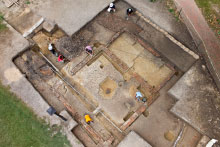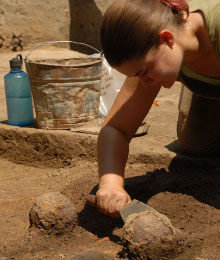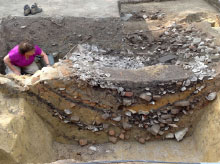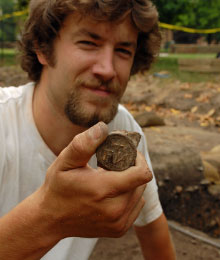
Wren Yard Excavation
A New Discovery on the Old Campus
During the summer of 2014, archaeologists explored an early 18th-century brick foundation just south of the College of William and Mary's Wren Building. Measuring approximately 18′ by 20′, with a 10′ addition, this building dates to the 1720s or 30s.
The structure was no longer standing by the time of the Revolution. Its traces remained hidden until the 21st century. It was finally discovered by William and Mary's Center for Archaeological Research in 2010.

Unsolved Mysteries
The building's function is still undetermined. Lacking a hearth or chimney base, it was probably not a house or a kitchen. Its unusual features—a central ash pit, and deep trenches around three interior walls—may provide clues to its function. A brewhouse (described in early college documents) or a laundry are currently among the most favored interpretations for its use.


Investigating the Sawpit
A sawpit just to the east of the foundation reveals an earlier chapter in the site's history. This large pit (23′ by 12′) was dug to prepare materials used to rebuild the Wren Building after a devastating fire in 1705. Once construction was completed around 1718, the sawpit became a dumping ground—filled with kitchen debris and scrap architectural material, including dressed stone, glass, and drawn lead used in casement windows.
The wide variety of artifacts recovered from the sawpit provides a fascinating look at early 18th-century life in Williamsburg. Because it is such an unusually rich feature and is on a protected property, only a portion was excavated in 2014. After excavation, the foundation and remaining portion of the sawpit were covered with filter cloth and clean compressible sand, and the site was backfilled. This will allow future study by archaeologists with new technology and different questions.
Continuing Analysis
Though the fieldwork is finished, this project is far from over. Research on the Wren Yard site has now moved into the archaeology lab. Over the next year or more archaeologists will wash, catalog, and analyze artifacts. Oyster shells and animal bones are currently being examined for information about climate, environment, and diet.
Comparisons between this site and similar archaeological discoveries will strengthen and refine our interpretation of the building's function and use.
